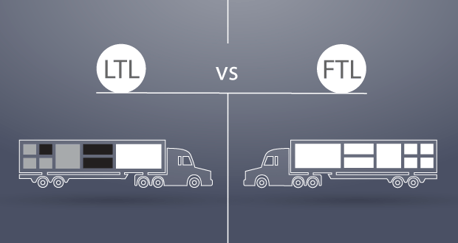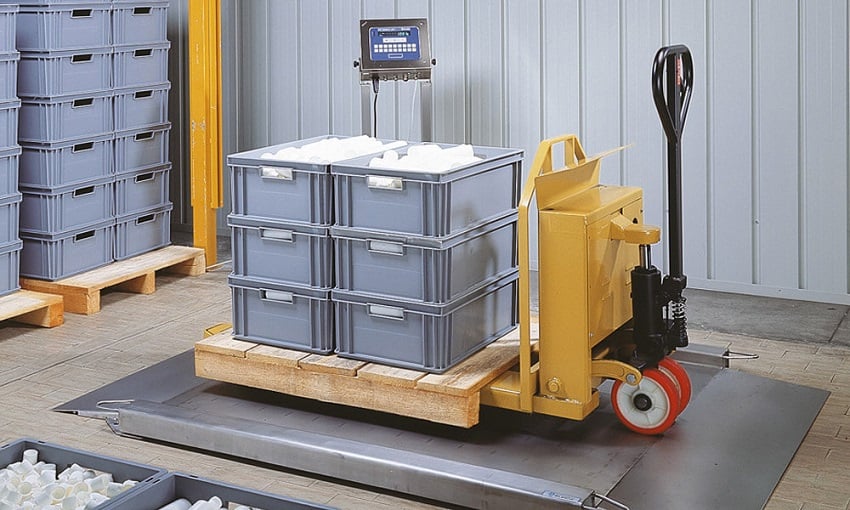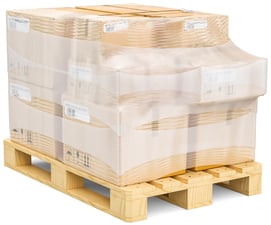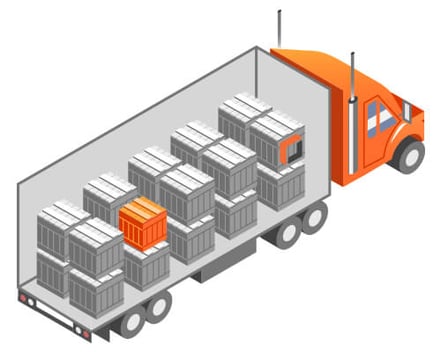By: Brian Katcher on April 21st, 2020
Shipping Less-Than-Truckload (LTL): How Are Rates Determined?
Less-than-truckload shipping, or LTL, is the transportation of relatively small shipments. They are typically under 10,000 pounds, six standard pallet positions or less, and do not require the entire trailer. When shipping LTL, shippers pay for the area on the trailer their shipment occupies. The other occupants of the trailer's space pay for the remainder of the cost.
LTL is a niche service within the transportation industry. There are hundreds of thousands of full truckload carriers but substantially fewer LTL carriers. Additionally, many LTL carriers operate within specific regions. In locations where few LTL carriers exist, it can be a challenge to coordinate service.
Choosing the right third-party logistics partner (3PL) to help can make all the difference. At Armstrong, we move over two hundred thousand loads per year, giving us buying power with LTL carriers, access to an extensive LTL carrier network, and competitive tariff rates.

For those new to LTL shipping, different LTL carriers' tariff rates can be confusing. All LTL carriers set their own tariffs, and they often vary greatly. Specific costs are nearly impossible to predict, as they fluctuate daily based on demand, fuel prices, and the exact parameters of the shipment.
In this article, we will discuss how rates are determined, the benefits of shipping via LTL, the alternatives, and other things to consider.
Factors That Determine LTL Shipping Rates
Several factors go into determining LTL rates. Below is a list of the most important or commonly used ones.
- Freight Classification
By far, this is the most important factor in determining the cost of LTL shipments. Incorrect classification leads to increased cost and additional fees, and you often won't see these added costs for several days. For example, suppose the items require special handling (i.e., liftgate, inside delivery, tradeshow, etc.), and this is not disclosed in advance. In that case, the invoiced rate will be higher than your initial quote.
There are 18 freight classifications ranging from 50 to 500, as established by the National Motor Freight Traffic Association. Class is based on the following: shipment density, value, stowability, handling, and liability.
In most cases, the lower the class, the lower the rate. Dense shipments receive a lower classification because they are harder to damage and easier to handle. Shipments with a higher classification are less dense and take up more space relative to the weight. These loads are more prone to damage and require special handling.
ClassIT is a helpful tool to determine classification. This is a paid service, so check with your organization or sign up online to access this information. Many of our Armstrong agencies can assist with freight classification as well.
- Weight
Many LTL carriers use centum weight (CWT), or hundredweight, to calculate rates. In this case, rates are quoted per 100 pounds. The carrier has a CWT calculation based on freight classification rates, shipment weight, and route distance. In general, the heavier the weight of the shipment, the less the shipper will pay per 100 pounds.

- Dimension
The dimensions and weight of the shipment will allow you to calculate density to help determine the freight class, which directly impacts rates.
Unusually shaped objects such as hockey sticks or gym equipment typically take up more space, thus increasing the shipping cost even if they weigh less than a standard pallet of steel bolts.
Here are a few ways you can minimize shipping and dimensional pricing costs:
Minimize your packaging. Don't use a larger-than-necessary box and fill it with packing peanuts or bubble wrap. Use an appropriately sized box instead.
Organize your pallets to maximize space. Load pallets evenly on top and the sides, creating level rows on the truck.
Train your warehouse and packing/loading staff. Holding your employees to clear and consistent standards will help to reduce overall costs in the long run.
- Distance
In general, the longer the distance, the higher the rate per pallet or hundredweight. The origin zip code and the destination zip code are used to determine the shipment's distance.
Most LTL carriers have multiple terminals in a specific state. If a particular LTL carrier's delivering terminal is located close to the shipment's consignee, these shipments tend to have lower rates than their competitors.
On the other hand, some LTL carriers only service a specific geographical area and therefore have to transload their shipment to a partner carrier to reach the shipment's final destination. This is called "interlining," which typically costs more and exposes loads to a higher risk of loss and damage.
Accessorial Charges to Consider
Anything that is out of the norm or requires extra time or effort will incur an additional fee from an LTL carrier. The best way to prevent this is to know what commodity is being shipped and any other services required at pickup and delivery.
The following are instances that commonly see extra fees after the load has been delivered:
- Extreme length, or any item over 8 feet.
- Nontraditional locations, especially those without a dock (i.e., church or temple, shopping mall, farm, or rural location).
- Liftgates, which are needed when the facility doesn't have a dock (typical for residential deliveries and small businesses). Essentially, a liftgate is a platform attached to the trailer that lowers the pallets from the trailer to the ground.
- Delivery appointments.
- Inside pick up/delivery.
- High-security facilities (i.e., government locations, guard shack, or check-in required).
What You Can Expect with LTL Shipping
When shipping with an LTL carrier, you can expect the following:
- No Direct Contact With the Driver
To confirm pickups have been completed, you'll need to reach out to the dispatcher or your shipper directly. Tracking can often be done on the LTL carrier's website or with the agent who booked your shipment. Delivery confirmation can usually be checked on an LTL carrier's online tracking system. If no online tracking is available, you'll need to reach out to the agent you booked the shipment with, the dispatcher, or the consignee directly.
- Packaging

LTL shipments should be strapped/shrink-wrapped to a pallet. In some cases, the commodity may even require it to be crated (e.g., an engine). LTL drivers will refuse to pick up freight that is not packaged correctly. Since LTL freight is handled many times during transit, shipping loose commodities puts cargo at risk for damage or loss.
- Longer Delivery Dates
Transit times are always estimated and do not include day-of pickup, weekends, or holidays.
- Inspection Fees
Inspection fees may apply for inaccurate information. Quotes are based on the information provided. If the information is incorrect, fees may be charged later.
Inspections have become easier to conduct and are more commonly done due to advanced technology like laser scanning, cameras, and other technology used to scan dimensions/weight quickly. This means the information provided on the weight/dimension must be accurate.
- Bill of Lading
The bill of lading must be from the entity paying for the freight. If the shipment is coming directly from the shipper, it can be their bill of lading. If a third-party logistics company is arranging the transportation, it must be their bill of lading. This is different from typical full truckload or even partial shipments.
Typically, to maintain discounted pricing and avoid additional billing fees, the bill of lading must be sent to the shipping location and given to the driver at pickup.
When Is LTL A Good Option?
If your shipment fits the following criteria, LTL could be a good option for you:
- Less than six standard pallets or 10,000 pounds.
- Flexible with transit time (shipment is not time-critical).
- It does not require refrigeration. If it does, you may be directed to a carrier who specializes in this.
Advantages of Using LTL
There are several advantages of using LTL, including:
 Reduction in shipping costs. Less space = lower rates.
Reduction in shipping costs. Less space = lower rates.- LTL carriers have robust back-office support: claims, legal, tracking, and billing. Their experienced teams, from drivers to dispatchers, often know the locations and specific needs of shippers/consignees very well.
- Technology for tracking is very reliable. Each item is labeled with a sticker and tracked from pickup to linehaul to delivery.
- Emphasis is increasingly being placed on being green and taking care of the planet. Shipping via LTL reduces the overall carbon footprint of each shipment by sharing trailer space.
When Is LTL NOT A Good Option?
LTL is not always the best option. Below are a few example situations where an alternate shipping method should be considered.
- Tight Deadlines
When the product needs to be delivered at a specific time, or it's on a tight schedule, LTL is not a good option. The last thing a vendor or broker wants to be responsible for is shutting down an entire production line because one piece didn't arrive on time.
For example, when the consignee location is not close to the LTL terminal, the carrier might only go to that location on specific days of the week.
Many LTL carriers won't wait in lines, so if the shipment is located in a bustling distribution center, it might not get picked up the same day.
- Expensive Items
Expensive items that need to be shipped securely, like electronics, are more likely to be damaged or subject to theft.
- Temperature-Controlled
It's difficult to ensure that products requiring precise temperature control, like steak or seafood, will remain at a stable temperature throughout transit.
- Delicate or Irreplaceable Items
The Mona Lisa is probably not going to be shipped with an LTL carrier. Valuable items like original artwork should be moved with a more secure method.
Choosing the Right 3PL Partner Can Help You Decide
If you are still wondering whether or not LTL is the right choice for your shipment, consider working with a reputable 3PL to assist you. You can eliminate the guesswork and potentially save money in the process.
If you think LTL could be the right fit for your business, connect with one of Armstrong’s LTL professionals today to find out more.


